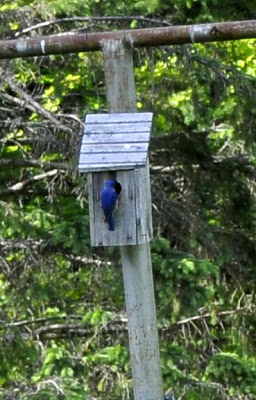
Photo by Mitch Nusbaum
From astronomy buff and hawkwatcher Mitch Nusbaum--
The Riverside Pair: There is a new nest in the same tree in
Though we'd love for the Riverside Pair to double clutch this season, it may not be what happens. In the past when their three eyasses died of rat poison they began a second nest and there were sporadic reports of copulation but they, in the end, did not have a second brood.
There is an arc of hormones that leads to nesting and when the sequence is disrupted, as in this current case the nest falling to the ground killing their three young, the descending cascade of hormones creates a similar set of behaviors. In some cases the hormones continue descending and a second clutch does not occur even though initial behaviors appear that that may happen.
In other cases, such as in the disappearance of the eggs in the Trump Parc nest of Charlotte and Pale Male Jr. in 2005, a new set of eggs was laid, eyasses hatched, and fledged. It isn't completely clear why double clutching occurs in some cases and not in others.
More from Mitch-- Meanwhile at the Cathedral nest, at 4:30PM Saturday, 5/21 One of the parents made a visit. After she left 1 eyass was up and about at 4:40P. That eyass is sporting an Orangy chest. Photo above taken at 4:50PM...
From professional photographer and birdwatcher Francois Portmann also at the Cathedral nest later the same day as Mitch only a little later on 5/21-
Sad news for the Divines!
I was watching the nest Thursday morning and saw only 1 eyass,
today (Saturday, 5/21/2010) I went back early, curious about the 2nd nestling!
At first, same scenario with one chick,
then an adult flew in around 6:30 with a twig and started to reach deep in the nest
and pulled up a dead eyass! Perhaps trying to get it off the nest but looked too heavy and let it go down out of sight again!
It was brief but clearly showed the dead eyass (have it on video footage)
Frounce? Rat poison? Weather? Who knows?
Would be interesting to test the carcass if the pair manage to get it off the nest!
Sorry to be the messenger
Best
Francois
After visiting the Unisphere yesterday evening, I noticed one of the eyasses (probably the oldest one) had fallen out of the nest and perished. I couldn't get to the body because of a fence surrounding the Unisphere during the rehab. period for the fountains below it. I will try to retrieve the body another day when the contractors are there.
Regards,
Peter
Better news from excellent birder Rob Jett--
This week I surveyed the three known
hatchlings were progressing.
The easiest nest for viewing is the pine tree at the edge of Nelly's
Lawn in
raising three offspring. When I visited the nest yesterday afternoon,
Nelly was busy feeding her brood. They all seem healthy and have
started to grow adult body feathers. Their wing feathers are also
growing in rapidly. In the video I shot one youngster is already
attempting to flap-hop to the opposite side of the nest.
I found a new and fairly decent viewing spot for
Ravine nest. Over two days I monitored their nest for an hour each
time and was only able to confirm a single hatchling. Although, the
nest is very deep and the viewing angle quite steep, so there could be
another chick. The chick that I watched is well behind the ones at
Nelly's Lawn and likely most of the city's Red-tailed Hawk chicks. It
is still mostly covered with down with maybe an inch of adult feathers
seen emerging from its tail and wings.
At approximately 75 feet up in a
nest is the highest and most difficult to get a chick count. My friend
Marge and I watched the nest for a long time this week and only got
fleeting glimpses of an erratic, white wing flipping up above the edge
of the nest. Big Mama was sitting at the nest watching her offspring
the entire time we were present. Perhaps in another week the chick(s)
will be large enough to view clearly. I will keep you posted.
I have a short video and a couple of pics here:
http://citybirder.blogspot.com/2010/05/red-tailed-hawk-update.html
Rob
Donegal Browne



































































